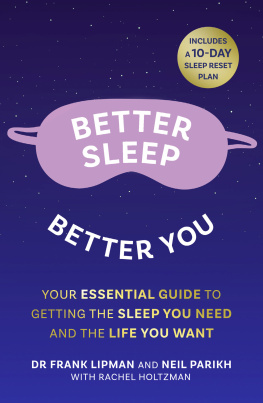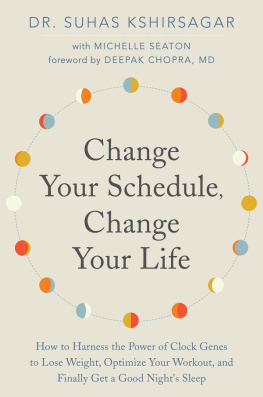
WRITE-ON PAGES
Any references to writing in this book refer to the original printed version.
Readers should write on a separate piece of paper in these instances.
Russell Foster
LIFE TIME
The New Science of the Body Clock, and How It Can Revolutionize Your Sleep and Health

PENGUIN BOOKS
UK | USA | Canada | Ireland | Australia
New Zealand | India | South Africa
Penguin Books is part of the Penguin Random House group of companies whose addresses can be found at global.penguinrandomhouse.com.

First published by Penguin Life in 2022
Copyright Russell Foster, 2022
The moral right of the author has been asserted
ISBN: 978-0-241-99339-2
This ebook is copyright material and must not be copied, reproduced, transferred, distributed, leased, licensed or publicly performed or used in any way except as specifically permitted in writing by the publishers, as allowed under the terms and conditions under which it was purchased or as strictly permitted by applicable copyright law. Any unauthorized distribution or use of this text may be a direct infringement of the authors and publishers rights and those responsible may be liable in law accordingly.
This book is dedicated with love to Elizabeth, Charlotte, William and Victoria and to the memory of Doreen Amy Foster (17 August 193328 November 2020)
List of Figures
Examples of 24-hour daily changes in human physiology.
Human brain and SCN.
Levels of light encountered in the environment and the approximate sensitivities of rod, cone and pRGC photoreceptors in humans.
Illustration of sleep/wake patterns.
The changes in oestrogen and progesterone across the female menstrual cycle leading to ovulation.
Cognitive performance across the day for adults and teenagers.
Model showing the relationships between mental illness and SCRD.
Circadian changes in disease events and disease severity.
The mechanisms that increase and decrease blood glucose. (A) Increasing blood glucose. (B) Decreasing blood glucose.
Immune system.
List of Tables
The impact of SCRD upon human biology.
Summary of what actions can be taken to alleviate or mitigate aspects of SCRD.
Abbreviations
| A | amyloid (plaques) |
| ADHD | attention deficit hyperactivity disorder |
| ADP | adenosine diphosphate |
| ANP | atrial natriuretic peptide |
| ASA | acetylsalicylic acid |
| ASD | autism spectrum disorder |
| ASPD | advanced sleep phase disorder |
| ATP | adenosine triphosphate |
| AVP | arginine vasopressin |
| BMI | body mass index |
| BPH | benign prostatic hyperplasia |
| BSB | Banking Standards Board |
| BST | British Summer Time |
| CBD | cannabidiol |
| CBTi | cognitive behavioural therapy for insomnia |
| COPD | chronic obstructive pulmonary disease |
| COVID-19 | coronavirus disease caused by the SARS-CoV-2 virus |
| CPAP | continuous positive airway pressure |
| CSA | central sleep apnoea |
| DDAVP | desmopressin |
| DSD | driver safety device |
| DSPD | delayed sleep phase disorder |
| DST | Daylight Saving Time |
| EEG | electroencephalogram |
| EMA | European Medicines Agency |
| EMF | electromagnetic field |
| FDA | US Food and Drug Administration |
| FSH | follicle-stimulating hormone |
| GABA | gamma-aminobutyric acid |
| GMT | Greenwich Mean Time |
| GnRH | gonadotrophin-releasing hormone |
| HbA1c | glycated haemoglobin |
| hCG | human chorionic gonadotrophin |
| HDL | high-density lipoprotein |
| HRT | hormone replacement therapy |
| IVF | in vitro fertilization |
| LDL | low-density lipoprotein |
| LE | light emitting |
| LH | luteinizing hormone |
| NAFLD | non-alcoholic fatty liver disease |
| NASH | non-alcoholic steatohepatitis |
| NDD | neurodevelopmental disorder |
| NREM | non-rapid eye movement sleep |
| nVNS | non-invasive vagal nerve stimulation |
| OCD | obsessive-compulsive disorder |
| OHS | obesity hypoventilation syndrome |
| OPN4 | opsin gene encoding melanopsin |
| OSA | obstructive sleep apnoea |
| PD | Parkinsons disease |
| PKC | protein kinase C |
| PMDD | premenstrual dysphoric disorder |
| PMS | premenstrual syndrome |
| PPI | proton-pump inhibitor |
| pRGC | photosensitive retinal ganglion cell |
| PRR | pattern recognition receptor |
| PTSD | post-traumatic stress disorder |
| RBD | REM sleep behaviour disorder |
| REM | rapid eye movement sleep |
| RLS | restless-legs syndrome |
| SBD | sleep-related breathing disorder |
| SCN | suprachiasmatic nuclei |
| SCRD | sleep and circadian rhythm disruption |
| SDB | sleep-disordered breathing |
| SRED | sleep-related eating disorder |
| SRMD | sleep-related movement disorder |
| SSRI | selective serotonin reuptake inhibitor |
| SWS | slow-wave sleep |
| THC | tetrahydrocannabinol |
| TIA | transient ischemic attack |
| TNF | tumour necrosis factor |
| TST | total sleep time |
Introduction
Nothing in life is to be feared, it is only to be understood. Now is the time to understand more, so that we may fear less.
Marie Skodowska-Curie
Forty years ago, as an undergraduate studying zoology at the University of Bristol, I knew I wanted to be a scientist, but I had little real idea of what that meant or involved. The body clock was just a fuzzy concept in my young, unfocused free-wheeling brain. However, during the final year of my undergraduate degree, I was a volunteer helper at an international meeting on biological rhythms. The job was not demanding, and I swanned about listening to the lectures and met the then leaders of the field. With the confidence perhaps arrogance of youth, I assumed that these scientific titans would want to speak to me just as much as I wanted to speak to them. Most were incredibly generous with their time, although I did learn not to approach one very senior professor over breakfast (its amazing how much meaning can be conveyed in a stony silence and a fixed stare at a greasy sausage ). It was a formative experience at many levels, and I soaked up the science like a sponge. Without my knowing it, this symposium defined my life-long interests and sparked an ambition to join this extraordinary group of international academics who were working on the fast-emerging science of biological time. My career as a scientist, from my undergraduate days to my current position as Professor of Circadian Neuroscience and Director of the Sir Jules Thorn Sleep and Circadian Neuroscience Institute at Oxford has allowed me to gain insights from, and occasionally share new knowledge with, colleagues from all over the globe. In a sense, this book represents the distillate of what I have learnt in studying the nature of biological time over the course of four decades. My hope is that I can convey to you some of the excitement, wonder and undiluted pleasure I have experienced over the years.
Next page













